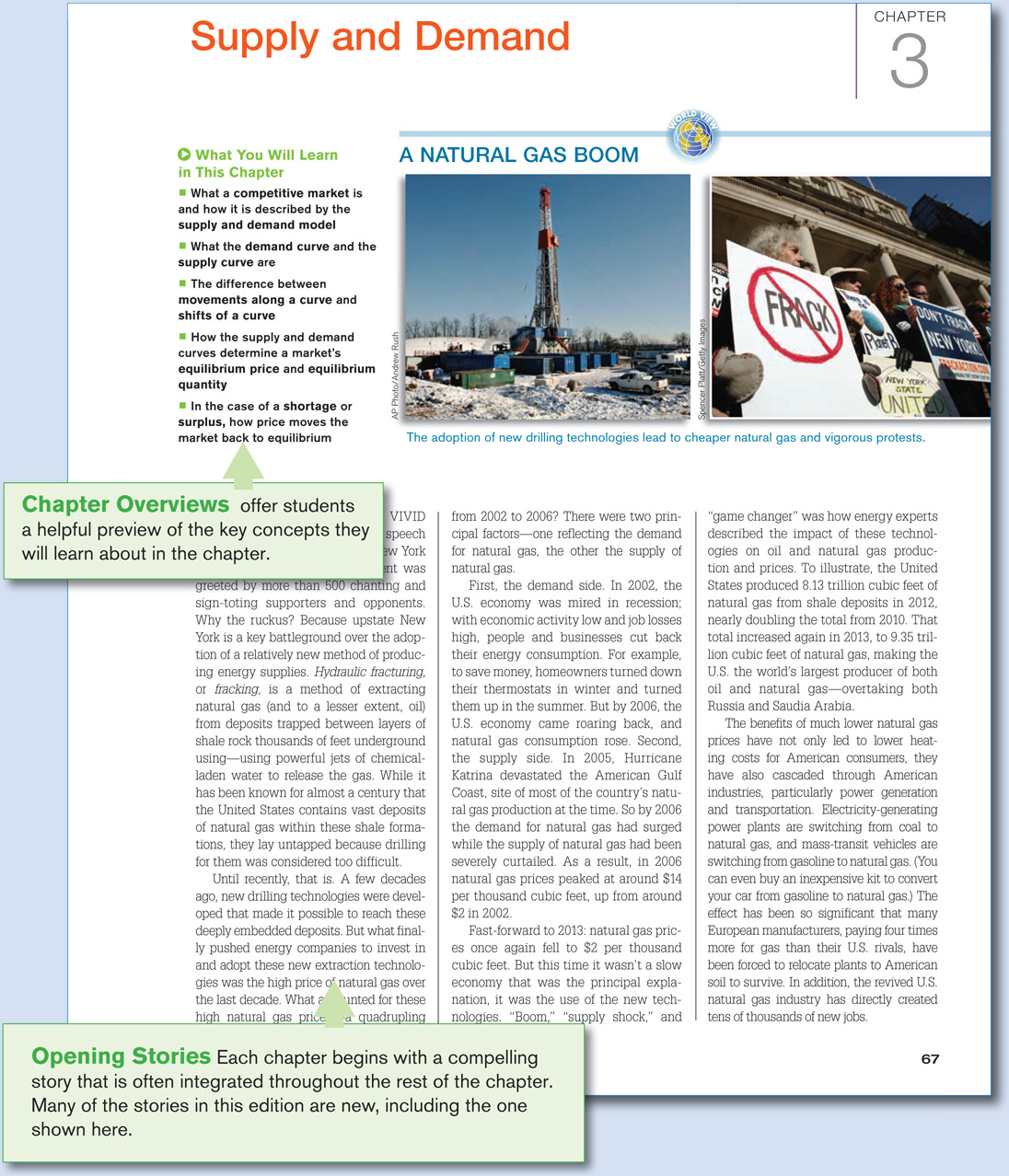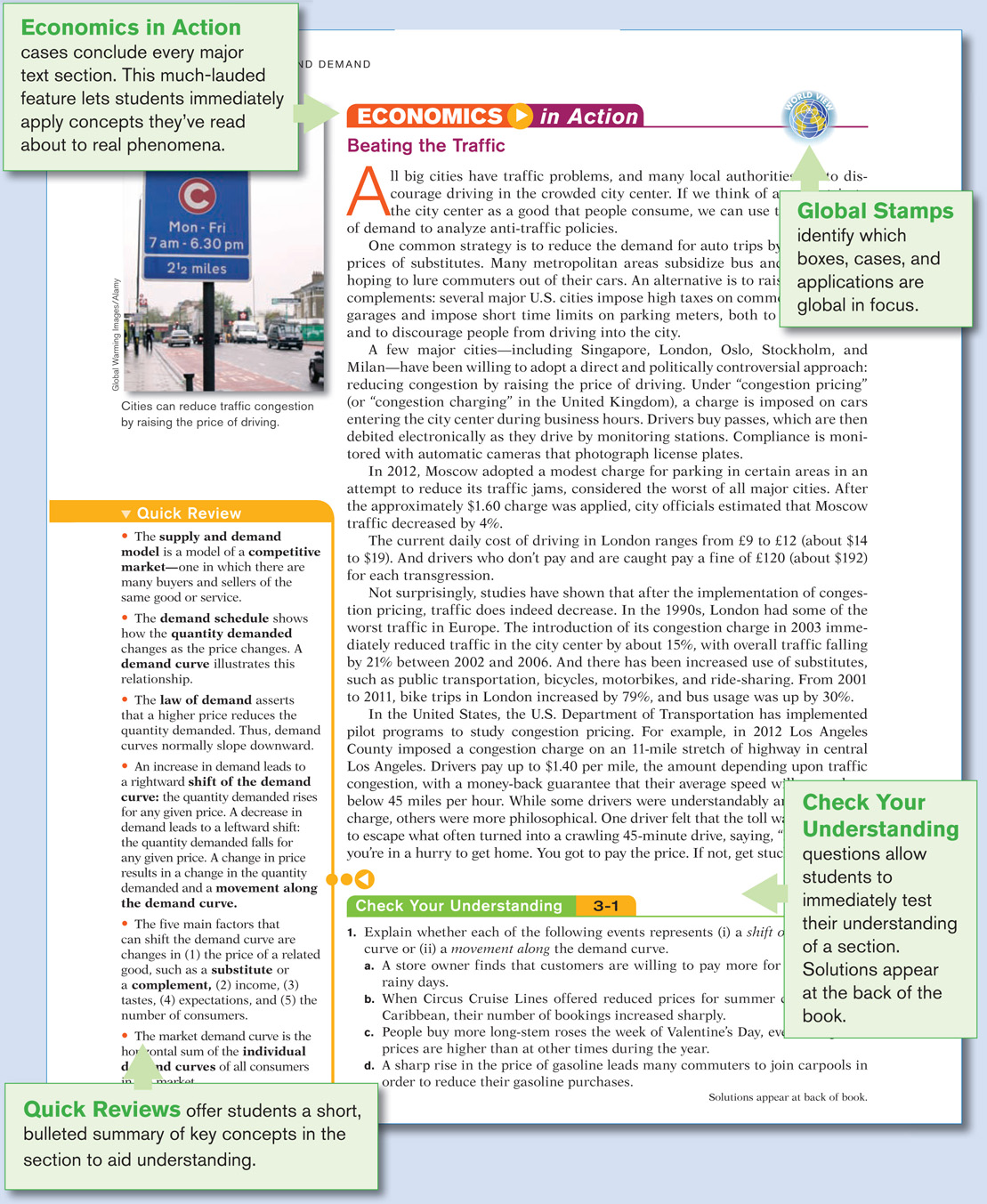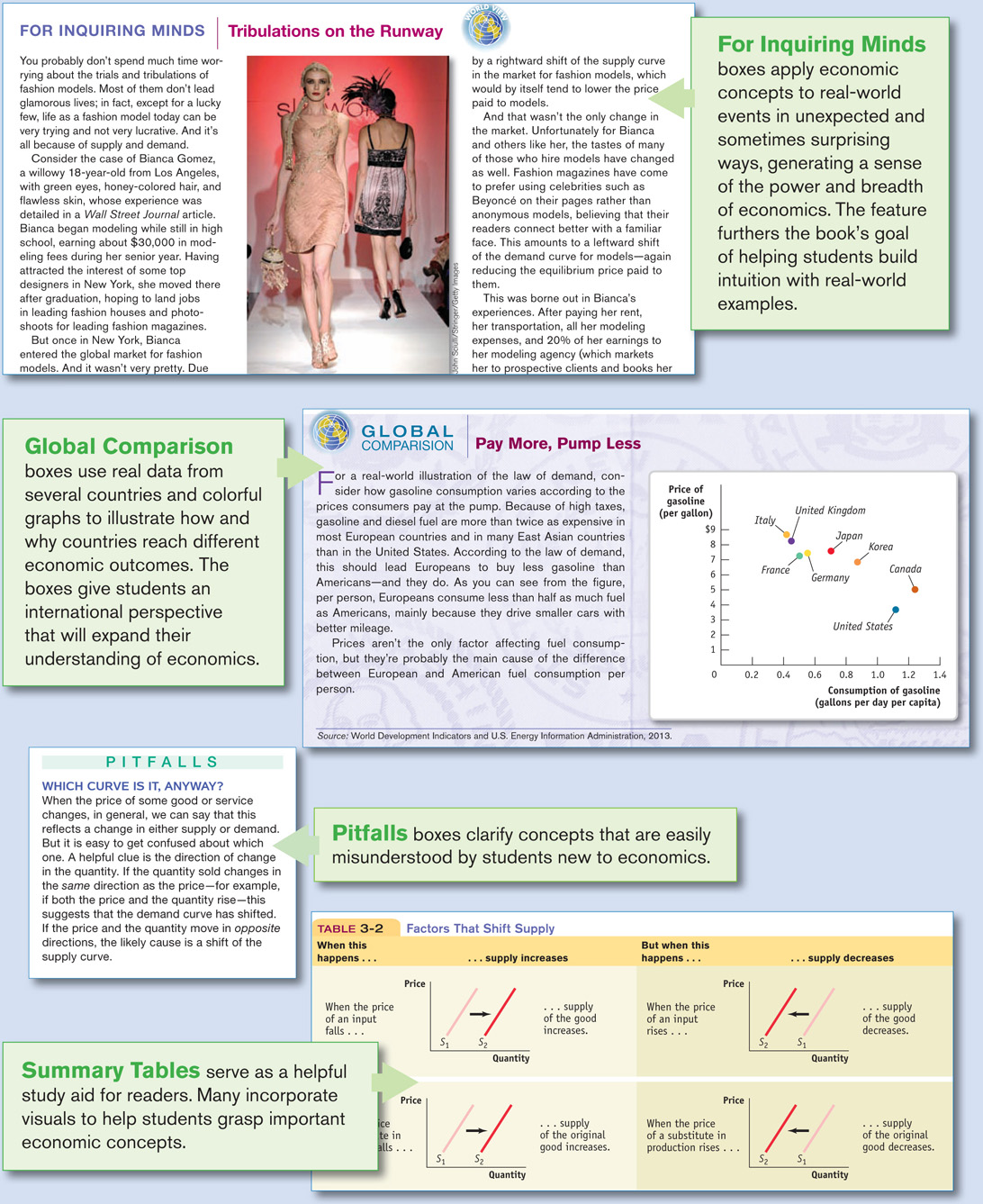|
|
|
|
Introduction: The Ordinary Business of Life
Initiates students into the study of economics with basic terms and explains the difference between microeconomics and macroeconomics.
|
-
Outlines 12 principles underlying the study of economics: principles of individual choice, interaction between individuals, and economy-wide interaction.
Economic Models: Trade-offs and Trade Employs two economic models—the production possibilities frontier and comparative advantage—as an introduction to gains from trade and international comparisons.
|
|
|
Chapter 2 Appendix: Graphs in Economics
Offers a comprehensive review of graphing and math skills for students who would find a refresher helpful and to prepare them for better economic literacy.
|
-
Covers the essentials of supply, demand, market equilibrium, surplus, and shortage.
Consumer and Producer Surplus Introduces students to market efficiency, the ways markets fail, the role of prices as signals, and property rights. Price Controls and Quotas: Meddling with Markets Covers market interventions and their consequences: price and quantity controls, inefficiency, and deadweight loss. -
Introduces the various elasticity measures and explains how to calculate and interpret them, including price, cross-price and income elasticity of demand, and price elasticity of supply.
-
Covers basic tax analysis along with a review of the burden of taxation and considerations of equity versus efficiency. The structure of taxation, tax policy, and public spending are also introduced.
|
|
|
Here we trace the sources of comparative advantage, consider tariffs and quotas, and explore the politics of trade protection. The chapter includes coverage on the controversy over imports from low-wage countries.
|
Decision Making by Individuals and Firms Microeconomics is a science of how to make decisions. The chapter focuses on marginal analysis (“either–or” and “how much” decisions) and the concept of sunk cost; it also includes a section on behavioral economics, showing the limitations of rational thought. -
Provides a complete treatment of consumer behavior for instructors who don’t cover indifference curves, including the budget line, optimal consumption choice, diminishing marginal utility, and substitution effects.
|
|
|
Chapter 10 Appendix: Consumer Preferences and Consumer Choice
Offers more detailed treatment for those who wish to cover indifference curves.
|
Behind the Supply Curve: Inputs and Costs Develops the production function and the various cost measures of the firm, including discussion of the difference between average cost and marginal cost. Perfect Competition and the Supply Curve Explains the output decision of the perfectly competitive firm, its entry/exit decision, the industry supply curve, and the equilibrium of a perfectly competitive market. -
A complete treatment of monopoly, including topics such as price discrimination and the welfare effects of monopoly.
-
This chapter focuses on defining the concept of oligopoly along with basic game theory in both a one-shot and repeated game context. Coverage of the kinked demand curve now appears online.
Monopolistic Competition and Product Differentiation The chapter emphasizes instances in which students encounter monopolistic competition, covering the entry/exit decision, efficiency considerations, and advertising. -
Significantly revised and updated in the new edition, the chapter covers negative externalities and solutions to them, such as Coasian private trades, emissions taxes, and a system of tradable permits. Also examined are positive externalities, technological spillovers, and network externalities.
Public Goods and Common Resources Explains how to classify goods into four categories (private goods, common resources, public goods, and artificially scarce goods) based on excludability and rivalry in consumption, in the process clarifying why some goods but not others can be efficiently managed by markets.
|
|
|
The Economics of the Welfare State
Significantly revised and updated, this chapter provides a comprehensive overview of the welfare state as well as its philosophical foundations. Examined in the chapter are health care economics (including new coverage of the Affordable Care Act), the problem of poverty, and the issue of income inequality.
Factor Markets and the Distribution of Income and Appendix: Indifference Curve Analysis of Labor Supply
>Covers the efficiency-wage model of the labor market as well as influence of education, discrimination, and market power. The appendix examines the labor-leisure trade-off and the backward bending labor supply curve.
Uncertainty, Risk, and Private Information
This unique, applied chapter explains attitudes toward risk, examines the benefits and limits of diversification, and considers private information, adverse selection, and moral hazard.
|
Macroeconomics: The Big Picture Introduces the big ideas of macroeconomics with an overview of recessions and expansions, employment and unemployment, long-run growth, inflation versus deflation, and the open economy.
|
|
GDP and CPI: Tracking the Macroeconomy Explains how the numbers macroeconomists use are calculated and why, including the basics of national income accounting and price indexes. |
|
Unemployment and Inflation Covers the measurement of unemployment, the reasons why positive employment exists even in booms, and the problems posed by inflation.
|
|
-
Emphasizes an international perspective—economic growth is about the world as a whole—and explains why some countries have been more successful than others.
|
|
Savings, Investment Spending, and the Financial System Introduces students to financial markets and institutions, loanable funds and the determination of interest rates. Includes coverage of present value in the chapter proper and in an appendix.
|
Chapter 25 Appendix: Toward a Fuller Understanding of Present Value
Expands on the coverage of present value in the chapter.
|
-
Addresses the determinants of consumer and investment spending, introduces the famous 45-degree diagram, and explains the logic of the multiplier.
|
Chapter 26 Appendix: Deriving the Multiplier Algebraically
A rigorous and mathematical approach to deriving the multiplier.
|
Aggregate Demand and Aggregate Supply Provides the traditional focus on aggregate price level using the traditional approach to AD-AS. It also covers the ability of the economy to recover in the long run.
|
|
-
Provides an analysis of the role of discretionary fiscal policy, automatic stabilizers, and long-run issues of debt and solvency.
|
Chapter 28 Appendix: Taxes and the Multiplier
A rigorous derivation of the roles of taxes in reducing the size of the multiplier and acting as an automatic stabilizer.
|
Money, Banking, and the Federal Reserve System Covers the roles of money, the ways in which banks create money, and the structure and the role of the Federal Reserve and other central banks.
|
|
-
Covers the role of Federal Reserve policy in driving interest rates and aggregate demand. It includes a section bridging the short and long run by showing how interest rates set in the short run reflect the supply and demand of savings in the long run.
|
Chapter 30 Appendix: Reconciling the Two Models of the Interest Rate
This appendix explains why the loanable funds model (long-run discussions) and the liquidity preference approach (short-run discussions) are both valuable.
|
Inflation, Disinflation, and Deflation Covers the causes and consequences of inflation, the large cost deflation imposes on the economy, and the danger that disinflation leads the economy into a liquidity trap.
|
|
|
|
-
Provides an up-to-date look at the recent financial crisis, starting with the Lehman Brothers collapse, integrating coverage about the dangers posed by banking, shadow banking, asset bubbles, and financial contagion.
|
|
|
Macroeconomics: Events and Ideas Provides a unique overview of the history of macroeconomic thought, set in the context of changing policy concerns, and the current state of macroeconomic debates.
|
|
|
Open-Economy Macroeconomics Analyzes special issues raised for macroeconomics in an open economy: a weak dollar, foreign accumulation of dollar reserves, and debates surrounding the euro.
|




